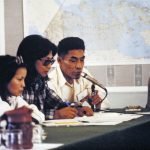1969
The Rise of Indigenous Women Leaders
1969 was a watershed year for Indigenous women leaders in the NWT. Agnes Semmler, Nellie Cournoyea, Ethel Blondin-Andrew, and Georgina ‘Gina’ Blondin all demonstrated that women’s leadership roles were changing in the north. Many other women deserve to be recognized; these four represent the power of many who came before and after working to amplify Indigenous voices in the Northwest Territories.
Agnes Semmler founded the Committee for Original Peoples Entitlement (COPE) and helped establish an Inuvialuit land claim agreement for the Beaufort Delta. Her tireless work promoting Inuvialuit concerns prepared her to take on the role of the first president of COPE and begin the process of negotiations for the Inuvialuit land claims. Agnes was considered a pioneer. She was the first NWT female Justice of the Peace and Deputy commissioner and dedicated her life to Indigenous women’s issues.
Nellie Cournoyea also contributed to COPE. Elected for a territorial seat in 1979, she became the first female NWT Premier in 1991. She served in the NWT Legislature until 1995 and then as Inuvialuit Regional Corporation chairperson for over 20 years. Nellie Cournoyea propelled her Inuvialuit people into the second comprehensive northern land claim. She was, in the words of her legislative colleague, former premier Dennis Patterson, “a pivotal influence on the surviving and thriving of the Inuvialuit as a minority within the NWT. Her dedication to the Inuvialuit and the Northwest Territories earned her the Order of Canada in 2016.
In 1969, Ethel Blondin-Andrew was still finishing high school. Blondin-Andrew was educated at Grandin College and received her Bachelor of Education from the University of Alberta in 1974. She ran for the newly created federal riding of the Western Arctic in 1988. She would become the longest-serving Indigenous woman Member of Parliament in Canada, elected for 18 years and holding various federal ministerial appointments.
Gina Blondin served as an official NWT delegate to various national events and helped draw broader public interest in the cultural contributions of Indigenous people. Gina completed both a Bachelor of Education and a Master’s degree. She participated in commercial ventures, including working with Pat Carney (later federal minister and senator) and Gemini North creating two reports for the GNWT on the Mackenzie Pipeline Proposal. She was an executive assistant within the legislature and helped edit her father George Blondin’s book “When the World was New; the Stories of the Sahtu Dene.” She died in 1990 after battling cancer.
The changing roles of women, their participation in the emerging Indigenous governments and their inclusion in the councils and legislature presented the NWT with diverse and vital perspectives. Semmler, Blondin, Cournoyea and Blondin-Andrew exemplified the varied and capable women leading the Indigenous resurgence in the North.







